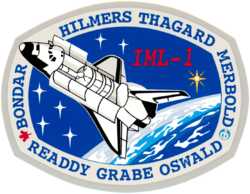STS-45
| STS-45 | |||||
 | |||||
| Uppdrag | 46 | ||||
|---|---|---|---|---|---|
| Rymdfärja | Atlantis (11)[1] | ||||
| NSSDC-ID | 1992-015A[2] | ||||
| Färdens tid | 8 dagar, 22 timmar, 9 minuter, 28 sekunder | ||||
| Uppskjutning | |||||
| Startplats | Startplatta 39A vid Kennedy Space Center i Florida | ||||
| Start | 24 mars 1992, 8:13 a.m. EST | ||||
| Landning | |||||
| Landningsplats | Runway 33, KSC | ||||
| Landning | 2 april 1992, 6:23 a.m. EST | ||||
| Omloppsbana | |||||
| Varv | 142 st[3] | ||||
| Apogeum | 294 km | ||||
| Perigeum | 282 km | ||||
| Banlutning | 57,0° | ||||
| Sträcka | 5,211 miljoner km | ||||
| Besättning | |||||
| Befälhavare | Charles F. Bolden (3) | ||||
| Pilot | Brian Duffy (1) | ||||
| Uppdragsspecialister | David C. Leestma (3) Michael Foale (1) | ||||
| Nyttolastspecialister | Kathryn D. Sullivan (3) Byron K. Lichtenberg (2) Dirk D. Frimout (1) | ||||
 | |||||
| Kronologi Rymdfärjeprogrammet | |||||
| |||||
STS-45 var den fyrtiosjätte flygningen i det amerikanska rymdfärjeprogrammet, den elfte flygningen med rymdfärjan Atlantis. Den sköts upp från Pad 39A vid Kennedy Space Center i Florida den 29 september 1988. Efter nästan nio dagar i omloppsbana runt jorden återinträdde rymdfärjan i jordens atmosfär och landade vid Kennedy Space Center.
Se även
Referenser
- ^ NASA Space Shuttle Launch Archive Arkiverad 30 november 2013 hämtat från the Wayback Machine., läst 28 juli 2016.
- ^ ”NASA Space Science Data Coordinated Archive” (på engelska). NASA. https://nssdc.gsfc.nasa.gov/nmc/spacecraft/display.action?id=1992-015A. Läst 19 mars 2020.
- ^ Manned Astronautics - Figures & Facts Arkiverad 30 juli 2016 hämtat från the Wayback Machine., läst 28 juli 2016.
Externa länkar
 Wikimedia Commons har media som rör STS-45.
Wikimedia Commons har media som rör STS-45.
| ||||||||
| ||||||||||||||||||||||||||||||||
Media som används på denna webbplats
STS-45 Mission Insignia
STS-42 Mission Insignia
Författare/Upphovsman: Pascal (Flickr user: pasukaru76), Licens: CC0
Vostok spacecraft replica at the Technik Museum Speyer, Germany.
STS-49 Patch
- STS-49 Endeavour, Orbiter Vehicle (OV) 105, crew insignia (logo), the official insignia of the NASA STS-49 mission, captures space flight's spirit of exploration which has its origins in the early seagoing vessels that explored the uncharted reaches of Earth and its oceans. The ship depicted on the patch is HMS Endeavour, the sailing vessel which Captain James Cook commanded on his first scientific expedition to the South Pacific. Just as Captain Cook engaged in unprecedented feats of exploration during his voyage, on Endeavour's maiden flight, its crew will expand the horizons of space operations with an unprecedented rendezvous and series of three space walks. During three consecutive days of extravehicular activity (EVA), the crew will conduct one space walk to retrieve, repair and deploy the INTELSAT IV-F3 communications satellite, and two additional EVAs to evaluate the potential Space Station Freedom (SSF) assembly concepts. The flags flying on Endeavour's masts wear the colors of the two schools that won the nationwide contest when Endeavour was chosen as the name of NASA's newest Space Shuttle: Senatobia (Mississippi) Middle School and Tallulah Falls (Georgia) School The names of the STS-49 flight crewmembers are located around the edge of the patch. They are Commander Daniel C. Brandenstein, Pilot Kevin P. Chilton, Mission Specialist (MS) Pierre J. Thuot, MS Kathryn C. Thornton, MS Richard J. Hieb, MS Thomas D. Akers, and MS Bruce E. Melnick. Each crewmember contributed to the design of the insignia.
The STS-45 mission official crew portrait includes Brian Duffy, pilot (seated on left); and Charles F. Bolden, Jr., commander (seated on right). Standing on the back row (left to right) are Byron K. Lichtenberg, payload specialist 1; C. Michael Foale, mission specialist 3; David C. Leestma, mission specialist 2; Kathryn D. Sullivan, payload commander; and Dirk D. Frimout, payload specialist 2. The primary payload for the mission was the Atmospheric Laboratory for Applications and Science-1 (ATLAS-1). The mission launched aboard the Space Shuttle Atlantis on March 24, 1992 at 8:13:40am (EST).







